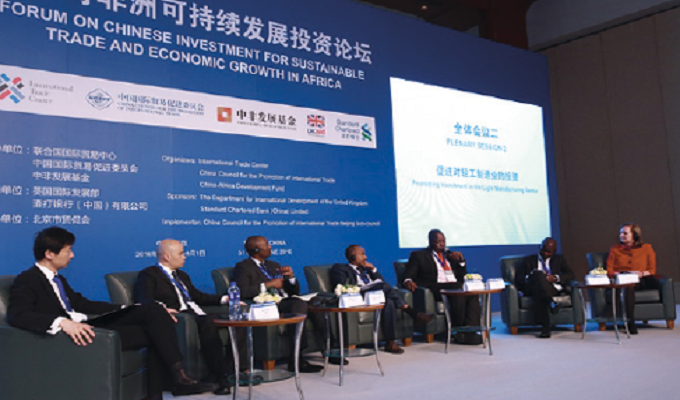

Facilitating China-Africa trade and investment for value addition and job creation
Much of Africa has experienced sustained high economic growth in the past decade. Maintaining this momentum and generating jobs for the continent’s growing young population will require continued structural transformation from low to high productivity activities and increased value addition within sectors.
China’s emergence as a leading investor and trading partner for many African countries presents major opportunities to drive inclusive growth. Yet while China is increasingly emphasizing the wider development dimension it is seeking to achieve through its investments in Africa, there are multiple constraints on the extent to which investment can flow to job-rich sectors such as agro-processing and light manufacturing. There are also constraints on the impact such investments have on poverty alleviation.
Rising costs at home are pushing Chinese manufacturers to develop production facilities abroad. Unlike their counterparts in the extractive and construction sectors, Chinese investors in manufacturing and agro-processing have relatively little experience doing business in Africa. They lack information and understanding about investment and trade opportunities, local labour laws and the broader business environment. For their part, African government institutions and small and medium-sized enterprises (SMEs) lack information about Chinese investors’ interests and requirements. The varying regulatory framework across different African countries can also dissuade potential investors. The cumulative result is that Chinese investments tend to focus on large projects in a limited number of sectors.
Institutional and cultural gaps also play a role. African countries’ investment promotion agencies are effective at attracting inward investment but often lack strategies for targeting Chinese investors. Coordination among trade and investment promotion agencies is frequently insufficient, leading to inadequate, incomplete replies to investor inquiries about possibilities for export-oriented investment. Language barriers and differences in business culture also hamper trust and understanding among African and Chinese business partners.
Maximizing the developmental and employment gains from foreign investment thus takes more than simple market forces alone.
The solutionIn Ethiopia, Kenya, Mozambique and Zambia, the Partnership for Investment and Growth in Africa (PIGA) project is working to encourage Chinese investment in the agro-processing and light manufacturing sectors and to ensure that this investment translates into inclusive growth and job creation.
Launched in October 2015, PIGA is a partnership between ITC, the United Kingdom’s Department for International Development (DFID) and the China-Africa Development Fund (CADFund). Project partners also include the China Council for the Promotion of International Trade (CCPIT) and trade and investment support institutions (TISIs) in Ethiopia, Kenya, Mozambique and Zambia.
The idea underlying the initiative is that enabling sub- Saharan African countries to capture more than their current sliver of global manufacturing activity would create productive jobs and stable growth. The primary impact of the project would be poverty reduction; as a by-product, China, the African countries and the United Kingdom hope to strengthen cooperation and generate useful learning on trade-related investment and development assistance, with a focus on SMEs.
In order to help African countries achieve the transition to higher productivity and more inclusive growth, the project will seek to stimulate export-oriented investments anchored in labour-intensive sectors.
The project opened with a scoping and design phase between November 2015 and March 2017, during which ITC worked to identify and start to tackle constraints facing exporters and investors in the four countries. These constraints ranged from inadequate market information and weak supply-side capacity to trouble overcoming regulatory barriers in export markets and obtaining financing for investment capital or to underwrite trade transactions. Alongside these efforts, ITC analysed each country’s export potential and investment opportunities while mapping out ongoing investment promotion efforts.
Two prominent events in China – a February seminar in Tangshan to promote investment in the four countries and a May meeting in Beijing on Chinese investment for sustainable trade and growth in Africa more broadly – enhanced awareness of the project among close to 500 investors, senior government officials, TISIs and business associations from Africa, China and the United Kingdom. More importantly, the meetings resulted in direct business linkages and the initiation of negotiations on potential investment projects.
Late in 2016 a meeting in Guangzhou brought together more than 200 African companies looking for joint ventures and Chinese investors to scale-up their businesses in Africa. During the event Chinese and African companies initiated investment deals that the project team will help bring to fruition through advisory services, follow-up visits and support to better equip African TISIs to facilitate inward investment from China.
The futureITC and its project partners are working to tackle institutional bottlenecks and policy constraints hampering the development of links between foreign investors and the broader local economy in Ethiopia, Kenya, Mozambique and Zambia. For each country, the project will develop investment guides and online information platforms in English and Chinese. It will also identify potential alignments of interest between Chinese investors and African companies’ supply chains and organize investment and export-oriented B2B events in China and the African countries.
By working on real investments and export deals with SMEs, foreign investors and buyers, the project will encounter many of the actual constraints that companies face in similar contexts. This will in turn yield lessons for policy action that go beyond general notions about constraints to investment. As a result, PIGA has the potential to make a significant contribution to the public stock of knowledge about what African countries can do to bolster integration into international value chains in labour-intensive sectors.
The project will also shed light on the potential multiplier effects that foreign investment in the agriculture and manufacturing sectors can create in terms of productivity growth, job creation, improved product quality and backward linkages to the rest of the economy.



